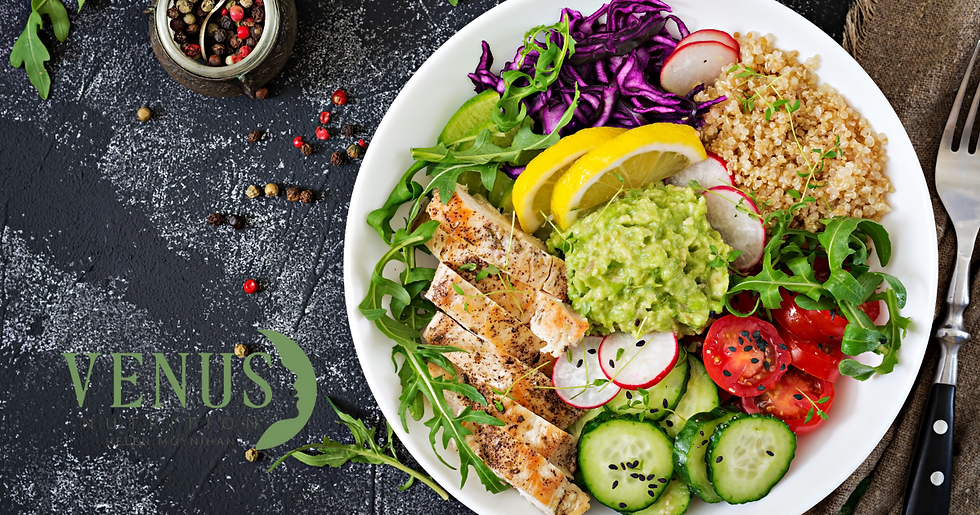What’s all the fuss about fermented foods?
- Jan 29, 2018
- 4 min read
Updated: May 14, 2024
One of my health goals for 2018 is to delve into fermented foods. I went to a great workshop at Tablehurst Farm in Forest Row a couple of weeks ago and now have my very own jars of kimchi and sauerkraut brewing in my kitchen!
Popular across cultures for centuries, fermenting has made a fashionable comeback as a provider of ‘good’ bacteria that contributes to a healthy digestive system. Want to know what the fuss is all about?
What are fermented foods?
Fermented foods are foods that have been through a process of lacto fermentation in which natural bacteria feed on the sugar and starch in the food creating lactic acid. This process preserves the food and creates beneficial enzymes, b-vitamins, omega-3 fatty acids and various strains of probiotics.
Natural fermentation of foods has also been shown to preserve nutrients in food and break the food down to a more digestible form. This, along with high levels of probiotics created during the fermentation process, could explain the link between consumption of fermented foods and improved digestion.
Cultures around the world have been eating fermented foods for years, from sauerkraut in Germany to kimchi in Korea. Studies have shown links between probiotic rich foods and overall health. Sadly, with the advances in technology and food preparation, these traditional foods have been largely lost in our society.
Where have all the fermented foods gone?
The amount of probiotics and enzymes available in the average diet has declined sharply over the last few decades as pasteurized milk has replaced raw, pasteurized yogurt has replaced homemade, and vinegar based pickles and sauerkraut have replaced traditional lacto-fermented versions.
Even grains were safer to eat in earlier times since their preparation included soaking, sprouting and fermenting, which largely reduces the anti-nutrient content and helps us to digest them.
Instead of the nutrient rich foods full of enzymes and probiotics that our grandparents probably ate, the average diet today consists mainly of sugar laden, lab created “dead” foods.
Fermentation can produce quite distinctive, strong, slightly sour flavours.
Why Eat Fermented Foods?
Besides the fact that they taste great and really grow on you, there are several great reasons to start making and eating fermented foods:
Probiotics – eating fermented foods and drinking fermented drinks like Kefir and Kombucha will introduce beneficial bacteria into your digestive system and help increase the diversity of bacteria in your digestive system. Probiotics have also been shown to help slow or reverse some diseases, improve bowel health, aid digestion and improve immunity!
Absorb Food Better – having the proper balance of gut bacteria and enough digestive enzymes helps you absorb more of the nutrients in the foods you eat. Pair this with a healthy balanced diet and you will absorb many more nutrients from the foods you eat.
Budget Friendly – incorporating healthy foods into your diet can get expensive, but not so with fermented foods. You can make your own fermented foods inexpensively – you can start with some cabbage and some salt!
Preserves Food Easily – lacto-fermentation allows you to store foods for longer periods of time without losing the nutrients you would with preserving food in a tin.
Probiotic powerhouses to include in your diet:
Kefir – a probiotic cultured drink, kefir contains multiple strains of bacteria and yeast. Kefir is rich in minerals and vitamins, particularly the B vitamins and vitamin K.
Sauerkraut – easy to make at home, this fermented cabbage dish has been around for centuries. It’s high in fibre, as well as vitamins A, C, K and various B vitamins. It’s also a good source of iron, manganese, copper, sodium, magnesium and calcium.
Miso – this traditional Japanese paste is made from fermented soybeans and grains consisting of millions of beneficial bacteria. It’s rich in essential minerals and a good source of various B vitamins, vitamins E, K and folic acid.
Kimchi – spicier than sauerkraut, kimchi is also a form of fermented cabbage and other vegetables. It contains vitamins A, B1, B2 and C and minerals such as iron, calcium and selenium.
Lassi – made from soured milk, lassi has been drunk as a pre-dinner yogurt drink for centuries. They are a popular way of achieving probiotic bacteria.
Kombucha – a fizzy, fermented black tea. Yeast turns sugar into alcohol and carbon dioxide, and bacteria called acetobacter convert the alcohol into acetic acid, giving it a sour taste. Watch out for sugar in shop-bought kombucha, you’re better off making it at home.
Tempeh – another version of fermented soy beans, it is a rich protein source so a good choice for vegetarians.
Sourdough bread – made from dough that is fermented.
Yoghurt – lactobacilli bacteria convert lactose sugar in milk into glucose and galactose, which break down further into lactic acid, giving yogurt its sour taste. Live bacteria remain in the yogurt and provide a valuable contribution to gut microflora.
Here is a link
for the easy sauerkraut recipe that I use (I replaced the white cabbage with red cabbage and added juniper berries) https://www.bbcgoodfood.com/recipes/simple-sauerkraut. More recipes to follow and how to include fermented foods in your day to day life next month!




Comments